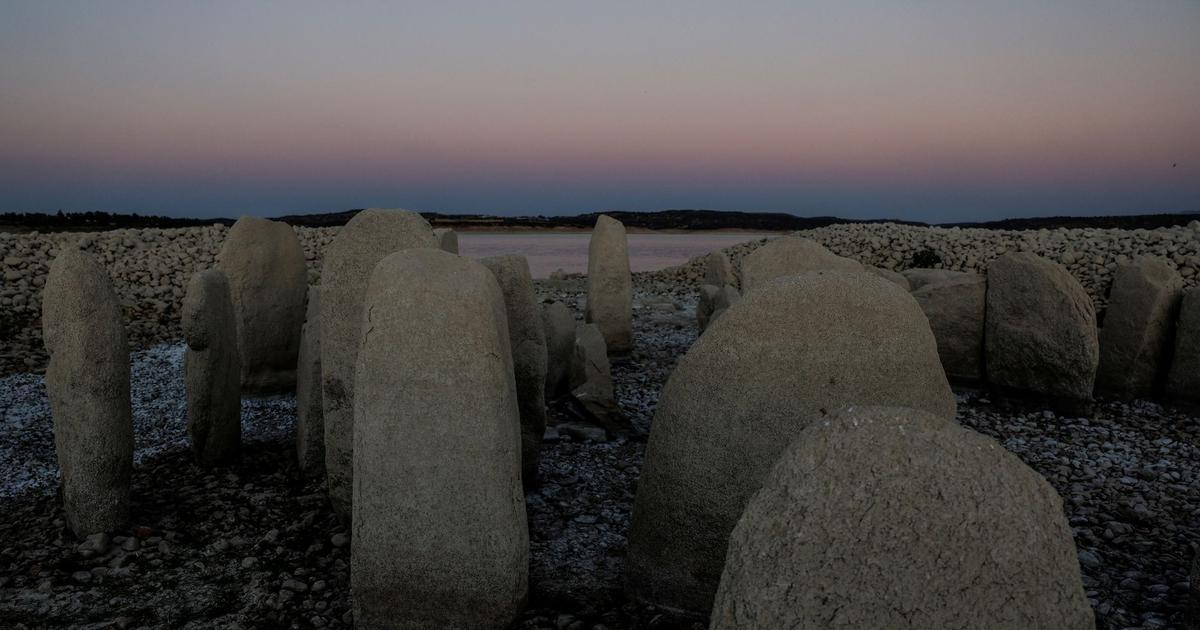The Spanish reservoir of Valdecanas, in the province of Cáceres, usually bathes at the foot of the ancient remains of the city of Augustobriga.
With the help of the drought, the diminished waters of the lake have made an infidelity to Roman Antiquity and this summer unveiled a much older place, bristling with polished stelae rather than sculpted columns.
Its name: Guadalperal.
Its megaliths, erected in the Neolithic period at least 4,000 years ago, have only emerged four times from the depths of Valdecanas since the reservoir was created in 1963. Nicknamed the "Spanish Stonehenge", this set of more than 150 orthostat stones, that is to say erect, once formed a dolmen covered with a motte.
The collective burial would have housed entire generations.
It was discovered in 1926 before being submerged, some forty years later, in favor of the development of agricultural land in the region.
Read alsoNotre-Dame de Paris: the investigation into the origin of the fire soon to be classified?
However, the wave of drought which hit the European continent this year has affected the Spanish reservoir, the water level of which fell in mid-August to 28% of its capacity.
While local farmers are showing their concern about the situation, the tourism sector is taking advantage of this rare opportunity to take visitors as close as possible to the standing stones of Valdecanas.
“The emergence of dolmens is resurrecting tourism
,” rejoiced the owner of a small boat to our colleagues at Reuters.
View of the Guadalperal site during its previous exposure, during the summer of 2019. Wikimedia Commons
The site had already come out of the waters in 2019, during a very arid summer.
The appearance of the site of Guadalperal is nonetheless rare and has delighted the Spanish specialists in megaliths.
"It's a surprise, we only rarely have the opportunity to have access to it,"
archaeologist and prehistorian Enrique Cedillo, from the Complutense University of Madrid, told the British press agency.
The archaeological site was classified in May as a Property of Cultural Interest by the Spanish authorities.
Read alsoIn Quimperlé, archaeologists discover the first stone of the former Capuchin convent
Iberian megaliths
The season will have been rich in megalithic discoveries.
Another group whets the scientific appetite of Spanish prehistorian circles.
In La Torre-La Janera between the Andalusian municipalities of Ayamonte and Villablanca (province of Huevla), 526 menhirs spread over an area of approximately 600 hectares have been counted since 2018 by researchers from the University of Huelva.
Increasingly promising, this space full of strings of megaliths would be one of the largest in Europe.
Views of one of the megalithic structures forming the ensemble of La Torre-La Janera.
Studied since 2018, the site would be the densest of its kind in the whole of the Iberian Peninsula.
University of Huelva/Junta de Andalucía
"This is the largest concentration with the greatest diversity of menhirs gathered on a single site in the Iberian Peninsula
," archaeologist José Antonio Linares told Agence France Presse.
The prehistorian co-authored a study published in the latest issue of the scientific journal
Trabajos de Prehistoria
which lists the latest discoveries made by researchers at La Torre-La Janera.
This site, which went unnoticed for millennia, is made up of menhirs, dolmens, tumulus, cistus and three megalithic enclosures from different periods, lists José Antonio Linares in a press release from the University of Huelva.
Read alsoThese ten archaeological sites that tell the story of France
If they do not outnumber the more than 3000 menhirs of Carnac, in Morbihan, the megaliths of La Torre-La Janera form a more variegated ensemble, built between the middle of the 5th and the beginning of the 2nd millennium BC.
Primitiva Bueno Ramirez, prehistorian at the Spanish University of Alcala and co-signer of the study published by
Trabajos de Prehistoria
, stressed to AFP
"the excellent conservation"
of these remains.
"That there are alignments and cromlechs on one and the same site is not so common,"
she added.
The submerged dolmen of Guadalperal and the prodigious complex of La Torre-La Janera, however, share the same sword of Damocles.
If it is not watched by the inevitable return of the waters, the Andalusian site was discovered during a prospecting campaign carried out before the development, by the owner of the land, of a field devoted to the avocado culture.
Researchers have until 2026 to thoroughly study La Torre-La Janera and its fascinating structures.
Beyond that, at least 92 hectares of the sector will be transformed into an agricultural plot, where the avocado tree will grow in the shade of ancient remains.







/cloudfront-eu-central-1.images.arcpublishing.com/prisa/JSZAI54QNNG2PE36BGH3NJUXQ4.jpg)
/cloudfront-eu-central-1.images.arcpublishing.com/prisa/DBT2OEOLXBGZTLYKDBM2FWSJNM.jpg)
/cloudfront-eu-central-1.images.arcpublishing.com/prisa/X65E77YIKRHXLGGMF7JFVXG2XQ.jpg)

/cloudfront-eu-central-1.images.arcpublishing.com/prisa/KMEYMJKESBAZBE4MRBAM4TGHIQ.jpg)



